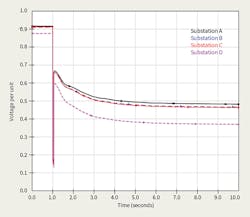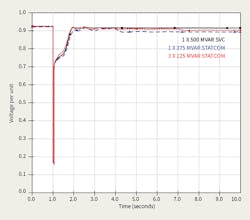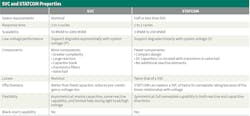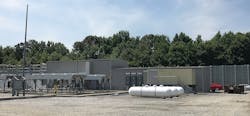After closing six coal-fired units in its eastern region — to comply with the U.S. Environmental Protection Agency’s mercury and air toxics standards — and managing an influx of new inverter-connected generators, Dominion Energy was facing a significant challenge. The utility needed an innovative approach to regulate voltage quality and reliability across its transmission system, specifically in the critical Hampton Roads area of Virginia.
Dominion Energy provides electric service to approximately 2.6 million customers in Virginia and North Carolina, U.S. The Hampton Roads area — which includes the cities of Chesapeake, Hampton, Norfolk, Newport News, Portsmouth, Suffolk and Virginia Beach — is home to a large military presence, one of the world’s largest natural harbors, the nation’s biggest shipyards, miles of beaches and many historical attractions. The importance of regulating system voltage to avoid service disruptions in this area is undeniable.
Dominion Energy used PSSE high-performance transmission planning and analysis software to perform power system studies and assess how its transmission system would respond to the loss of retired generation. Without this generation close to the load centers in Hampton Roads, a fault-induced delayed voltage recovery (FIDVR) for a single 230-kV line fault could cause multiple voltage violations and a possible voltage collapse. System studies using PSSE were developed for different load contingencies and possible N-1-1 grid configurations. These studies highlighted the need for 750 MVAR of fast capacitive compensation.
The Reliability Challenge
Dominion Energy’s traditional planning philosophy was to install one large static volt-ampere-reactive compensator (SVC) in a central location, with a design focused on minimizing initial costs. The traditional approach was not enough, however. Today’s threats and power-system needs have become more complex. Society’s dependence on electricity is greater than ever, while today’s grid faces multiple challenges and higher expectations for safety, reliability and resiliency. Natural threats (such as hurricanes, tornados, derechos, earthquakes, polar vortices, solar storms and geomagnetic disturbances) as well as man-made threats (such as physical and cyber threats, electromagnetic pulse events and copper theft) are real and present dangers.
This complexity is compounded by inverter-connected generation. The rapid growth of wind and solar installations is producing voltage control and system protection issues that must be addressed for reliable operation. Dominion Energy recognized a single solution would struggle to solve all these grid requirements. A fresh, innovative look was necessary to meet the physical and reliability needs. By compiling a list of needs and risks, Dominion Energy created a unique vision to solve the current FIDVR issue and address future system needs, but a new set of design requirements and standards would need to be developed.
The Solution Converges
Traditional options for transient and steady-state voltage control included the installation of capacitor-reactor banks and a large SVC in a central location. Fixed solutions such as capacitor banks can be modeled and deployed easily, but they do not help with transient events. Recovery after faults is more difficult to tune and compensate evenly across a region with a single mitigation device such as a SVC.
In urban areas like Virginia Beach, multiple SVCs were not possible or practical; the construction of even one small SVC would require a considerable amount of land. A wide area or distributed application made more sense. Static synchronous compensators (STATCOMs) are a comparable technology that require a much smaller footprint than SVCs and offer multiple advantages. Studies were performed to see what compensation would be necessary to provide comparable voltage recovery.
After hundreds of system studies, Dominion Energy demonstrated a single 375-MVAR STATCOM could deliver the same compensation level as a single 750-MVAR SVC. To improve reliability and availability, three independent 125-MVAR STATCOMs were modeled and found to provide the best transient and steady-state compensation solution. To eliminate a single point of failure, Dominion Energy recognized a distributed solution would satisfy design needs while significantly reducing risk. The addition of an in-service spare, or a fourth STATCOM, proved to be the perfect option.
STATCOMs were installed at four existing substations in Chesapeake and Virginia Beach. Dominion Energy did not have to purchase any land to accommodate the STATCOMs. Construction was completed at the substations by April 2017.
Eliminating Risk
The Eastern Region STATCOM Project marked a significant milestone for Dominion Energy and the energy industry. It was the first time this many STATCOMs had been deployed in one area. The utility applied a trusted technology in a unique way, yielding an abundance of benefits.
An in-service spare provided N-1 coverage at a device level to ensure any one of the four STATCOMs could be out of service and still mitigate steady-state and transient voltage issues. The advantage of an in-service spare is that preventive maintenance and repairs can be completed any time of the year. With only a single SVC or STATCOM installation, maintenance can be performed only during certain load and weather windows, adding to the complexity of owning and operating the device.
The distributed solution also enables the installation of mitigation where it is needed. In Dominion Energy’s experience with the Eastern Region STATCOM Project, the STATCOMs could be installed within existing substations and required less land area compared to SVCs.
STATCOMs have several other advantages in an urban environment. The elimination of external capacitors and filter banks reduces the footprint. The elimination of shunt reactors reduces the noise and need for countermeasures. SVCs could require replacement of filter banks based on future changes to load types and system configurations. The faster operating speed of STATCOMs and the advantage of voltage source converters reduce the amount of compensation needed. Less compensation means fewer power losses, and depending on the way STATCOMs are operated, they can result in fewer power losses compared to SVCs.
The Hampton Roads area provides many challenges to substation design because of salt contamination and occasional hurricane flood surges. The reduction of bus work and outdoor equipment associated with STATCOMs eliminates the cost and need to design for the extra exposure. The elimination of additional pipe stands and equipment made the flood-related design easier. All equipment and control buildings were elevated 3.5 ft (1 m) and built to sustain Category 3 hurricane forces.
The initial concern about the interaction between multiple STATCOMs installed so close to each other posed an electrical challenge that could be easily overcome. The short-circuit strength of the power system affects the ability of SVCs or STATCOMs to compensate quickly. If the system is weak and STATCOMs react quickly, the voltage could overshoot or erratic operation could occur.
The addition of automatic gain, or the adjustment of STATCOM speed, and hunting controls act as autonomous speed control. If fast positive and negative oscillations occur from a system event, the STATCOMs automatically lower their gain and slow down their reaction time. To reset their gain, STATCOMs routinely test the system strength by injecting reactive power and measure the associated voltage change. If needed by system conditions, STATCOMs can adjust frequently to optimize both performance and speed.
All the concerns about operation and interactions were put to rest with real-time digital simulator (RTDS) simulations of the STATCOMs within the Dominion Energy system model. RTDS was used during final commissioning tests to validate the set points of each STATCOM control panel prior to deployment and installation.
Reduction in risk means designing redundant systems that eliminate single point of failure. Therefore, the design of each STATCOM has redundant controls and relays that feed from different AC and DC sources with multiple station services and backup generators, which enable STATCOMs to be used for black-start or restoration after a storm.
Proving Value
The deployment of multiple STATCOMs in different substation locations reduces the likelihood a single extreme weather event could damage all four units. This provides greater resiliency benefits to the network by increasing the probability that some, if not all, of the units would be available immediately following the event. Actual operation of the STATCOMs has exceeded expectations. Before construction of all STATCOMs was completed, Hurricane Matthew caused a wide-area outage of the transmission and distribution system in Hampton Roads. Having a tool to control high voltage accelerated customer restoration. Without customer load, transmission lines act like capacitor banks and can cause the system voltage to become too high for electrical equipment to tolerate.
In previous restoration efforts following severe weather, transmission lines were available for service but had to be de-energized until the distribution operating centers could ensure substations would have load to counter the high-voltage issue. This slowed the restoration process. Following Hurricane Matthew, the STATCOMs helped to reduce the restoration time by approximately one day because all the transmission assets were energized and waiting for the restored load. This flexibility — which enabled system operators to adjust reactive compensation on the fly — is a great operating tool that has generated unimagined long-term benefits.
The addition of backup generators to keep all control and auxiliary systems in a state of readiness has enabled the STATCOMs to become valuable black-start devices. They have been integrated into Dominion Energy’s system restoration plans. The generation retirements turned out to be an opportunity instead of an issue by giving the utility a new flexible tool for operations. By addressing new substation design concerns and mitigating risk through the elimination of single points of failure, the overall system has been strengthened.
The STATCOMs also have improved Dominion Energy’s ability to operate in both steady-state and short-circuit events, decreased operations on fixed reactive switching devices in the Hampton Roads region, and improved the restoration time during extreme weather events.Energy standards often do not reflect the change in reliability and availability needed by today’s electricity consumers. New threats and rapid changes stress the design of legacy electrical systems. Customers expect continuous, readily available and high-quality electric service. Utilities need to change the way they look at electric service. The same approaches used for the last 50 years are no longer acceptable. Imagination coupled with innovation is needed to provide the type of service customers now expect and demand. ♦
Mark McVey is a principal engineer in Dominion Energy’s transmission operations engineering organization. He holds a BSEE degree from Virginia Tech and has more than 35 years of experience in the energy industry. He serves as chair and is a member of several IEEE working groups. He also is actively involved in CIGRE and IEC working groups as a convener, advisor and U.S. delegate. These working groups are focused on capacitors, high-voltage and air-insulated substations, and standards.
Editor’s note: Dominion Energy’s Eastern Region STATCOM Project received the Southeastern Electric Exchange Chairman’s Award, which honors the project deemed most outstanding of all the category winners. Participants recognized include Mike Boyce, Bob Bryant, Paula Butz, Mark Donahue, Matthew Gardner, Ricky McPherson, Mark McVey, Jeff Peggs, Dave Pelkey, Don Porter, Mike Reid, Bill Smith and Kyle Thomas.
About the Author
Mark McVey
Principal Engineer
Mark McVey is a principal engineer for Dominion Energy in the transmission operations engineering department. With 35 years of engineering experience, McVey received his BSEE degree from Virginia Polytechnic Institute and State University in 1982. He is the current IEEE series capacitor working group chair and recent chair of the IEEE capacitor subcommittee, and also serves as a member on multiple other IEEE working groups. He is currently convener of CIGRE B3.46 and an advisor for CIGRE B3 air-insulated substations. McVey is an advisor for the United States for International Electrotechnical Commission (IEC) Technical Committee 33 capacitor 1000 V and above, and coauthor of the Standard Handbook for Electrical Engineers, Section 10.5 Power Capacitors. He is a senior member of the IEEE.





